Last updated on March 21, 2024
Are you looking for tips on how to win Eurojackpot? Then, stop using statistics and start using combinatorial math and probability. This guide will show how the game works and how to overcome common challenges. Ignore common myths and use math to make intelligent choices.
Let’s dive in.
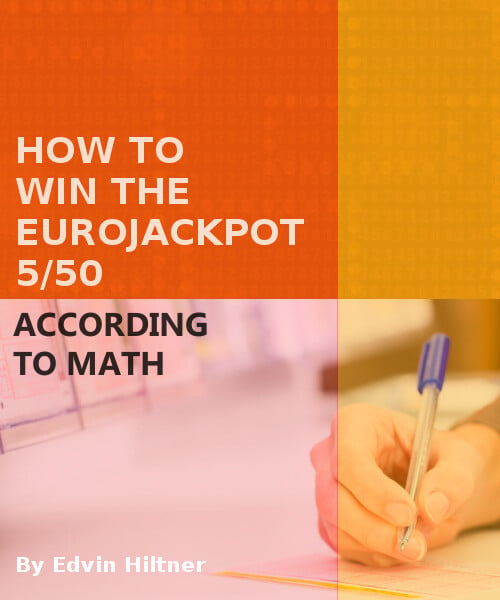
Table of Contents
The Odds of EuroJackpot
A game with a 5/50 format has 2,118,760 possible combinations. However, winning the jackpot requires matching two additional numbers out of 12. This pushes the probability of winning to 1 in 139,838,160.
You are more likely to be killed by a shark than to win the Eurojackpot, but no shark will attack you if you don’t swim in the ocean. It’s the same with the lottery: you can’t win without a ticket. You have to be in it to win it.
Fortunately, in addition to the jackpot, you can also win 11 more likely prizes ranging from €9 to €800,000, giving you 1 in 32 chances of winning any prize.1
So, based on the payout schedule of the Eurojackpot, the probability of one ticket not winning any prize is 0.9688. The probability of losing nth times is this number raised to the power of n. For example, the probability that you lose twice in a row is 94%.
P(losing twice) = 0.96882 tickets = 0.9384765625
Getting a 50/50 shot at winning any prize may require purchasing approximately 22 tickets. And to achieve a 99.99% certainty of winning a prize, you have to purchase 290 tickets. We use the complementary of P(losing) to calculate this probability of winning.2
P(winning any prize) = 1 – 0.9688290 tickets
It’s worth noting that the odds favor securing the lowest-tier prize. Therefore, this 99.99% guarantee will most likely give you €9.84 win. Probabilistically speaking, securing minor prizes in the Eurojackpot is difficult, let alone winning the jackpot. So don’t believe if someone says you can profit from the lottery.
Lottery playing cannot be a substitute for a full-time job due to its negative expected value.3
Be a Mathematical Eurojackpot Player
Winning a lottery game is difficult because the odds are too monumental. But apart from the odds, one of the main reasons you are not winning is not using the right number-selection strategy.
Some lottery players use quick picks, special dates, hot numbers, cold numbers, or even whimsical beliefs such as lottery spells, psychic reading, horoscope reading, numerology, and several superstitious approaches.
None of the above approaches work. If you want to know how to win the Eurojackpot, you must understand how lottery balls behave in a random game to win a jackpot.
Fortunately, a lottery game is deterministic despite being truly random, and I will provide proof later below.

People collect the previous draws and use statistics to determine the hot and cold numbers. Many Eurojackpot players mistakenly believe that statistics can give a clue on how to win.
The truth is that you don’t need statistics to understand how a random lottery game works. And this belief must be corrected once and for all.
Well, there are two mathematical tools you can use. The first is combinatorics.4 The second one is the probability theory.2
The two mathematical tools are the keys to helping you understand how lottery balls behave in a truly random lottery game, allowing you to determine your success-to-failure ratio. Read on: The Winning Lottery Formula Using Math
Decoding Eurojackpot Game’s Success-to-Failure Ratio
You cannot manipulate the underlying probability in a truly random game. You cannot beat the odds of the lottery no matter what you do.
So, how can we make intelligent choices if all numbers and combinations have the same probability?
Well, the key is the success-to-failure ratio.5
Let me start by defining the difference between odds and probability.6 Odds and probability are not mathematically equivalent.7
Below is the formula we use to calculate the probability:

We use the formula below to indicate your odds:

So, in calculating Eurojackpot’s outcome, odds will provide a better picture of your advantage. This calculation helps you see the difference between success and failure.
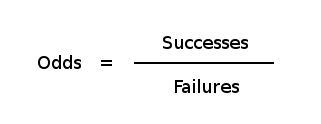
This success-to-failure ratio can be easily understood when we deal with combinatorial groups. Read on: The Winning Lottery Formula Using Math
Since combinations have different compositions, different combinatorial groups with varying success-to-failure ratios exist.
Let me give you an example.
There are 53,130 ways to combine 5-even numbers. This is an example of a combination without a single odd number. Since there are 2,118,760 possible combinations in a 5/50 game, this combination has a success-to-failure ratio of 1:39.
Odds_favor(5-even) = 53,130 / 2,065,630 = 1/39
This calculation indicates that a 5-even combination is expected to occur only once in 40 draws.
Let’s compare that to a more balanced class of combinations such as 3-odd-2-even.
Odds_favor(3-odd-2-even) = 690,000 / 1,428,760 = 1/2
The calculation indicates that a 3-odd-2-even combination is expected to occur 33 times in 100 draws.
We can easily see the difference if we compare the two side by side:
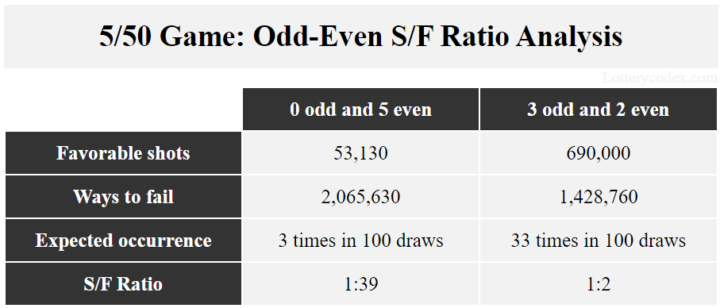
Calculated using Lotterycodex Calculator
As you can see, these mathematical calculations enable you to see varying success-to-failure ratios, allowing you to make intelligent choices. Read on: How to Win the Lottery According to Math.
As a Eurojackpot player, you don’t want to get only 2 or 3 favorable shots after playing 100 draws.
When you play Eurojackpot game, the first thing you should know is your success-to-failure ratio. You cannot change the underlying probability, and you cannot beat the lottery’s odds, but as a lotto player, you have the power to calculate different outcomes and make informed choices.
That is how math can help you make intelligent choices when playing.
EuroJackpot Follows the Dictate of Probability
A lottery game is always subordinate to the dictate of probability theory. Therefore, according to the law of large numbers, the actual results of a lottery game will always agree with probabilistic expectations.8
We compute the expected frequency of each combinatorial group using the following formula:
Expected frequency = probability X number of draws
From March 23, 2012, to March 15, 2024, EuroJackpot had 728 draws. So, in the case of 3-odd-2-even, we multiply 0.3256621797655230 by 728 draws.
Therefore, we get:
Expected frequency(3-odd-2-even) = 0.3256621 x 728 = 237
The calculation shows that a 3-odd-2-even combination is estimated to occur approximately 237 times in 728 draws.
Using the same computation for the rest of the odd-even patterns, we come up with the completed comparison graph below:
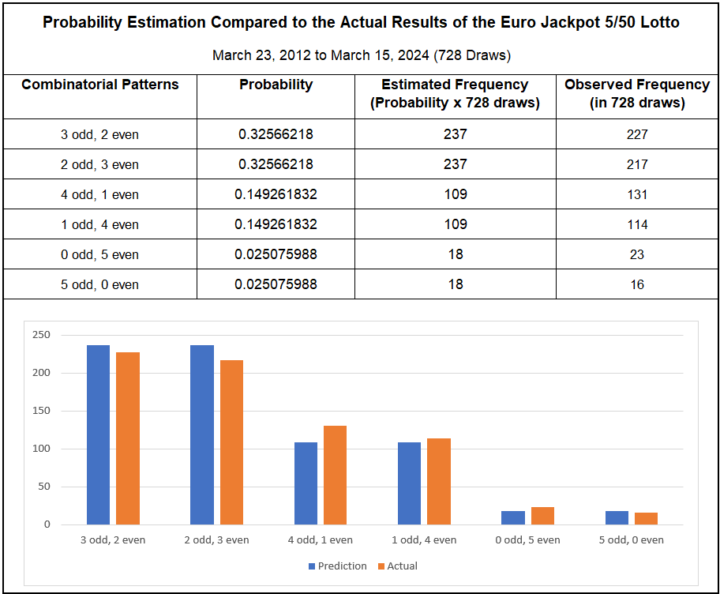
The agreement between prediction and actual results only proves that the EuroJackpot game follows the rules of probability. Math does not lie.
This also indicates that when playing a Eurojackpot game, you have the power to choose a combination that behaves like a random lottery.
For example, you probably don’t want to get just 13 favorable shots after playing 728 draws. The Eurojackpot game favors the 3-odd-2-even and 2-odd-3-even groups; consequently, most winning combinations belong to these groups.
According to probability theory, this expectation will happen because a random lottery game spreads the probability fairly between odd and even numbers. That’s why you rarely see a winning combination composed of purely even or odd numbers; the probability has no bias.
How to Choose The Best Numbers in EuroJackpot
Combinatorial math and probability theory can be problematic if done incorrectly.
It’s crucial that when you apply these two mathematical tools, the right methodology must be used.
For example, not all combinations belonging to 3-odd-2-even have a favorable success-to-failure ratio. One example of this is the 1-2-3-4-5 combination.
Based on our understanding of probability, a straight combination such as 1-2-3-4-5 cannot be a good choice since a truly random game distributes the probability across the number field. Therefore, a random lottery draw will not favor a combination with pure low numbers.
Fortunately, using the right method, we can apply combinatorial and probability analysis to accurately represent Eurojackpot’s random behavior.
Therefore, grouping the number field into odd and even numbers will not be sufficient. We have to include low and high numbers in the calculation process.
Lotterycodex combines odd/even and low/high numbers into a single combinatorial and probability analysis. This integration ensures that the probability is spread fairly across the number field and thus provides accurate information for decision-making.
Here’s how Lotterycodex divides the number field into four sets:
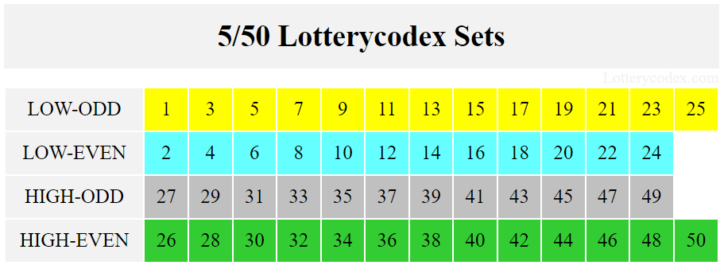
Generated by Lotterycodex calculator
The results of this combinatorial and probability analysis are Lotterycodex templates.
These Lotterycodex templates will tell you accurately which combinations will dominate the Eurojackpot game.
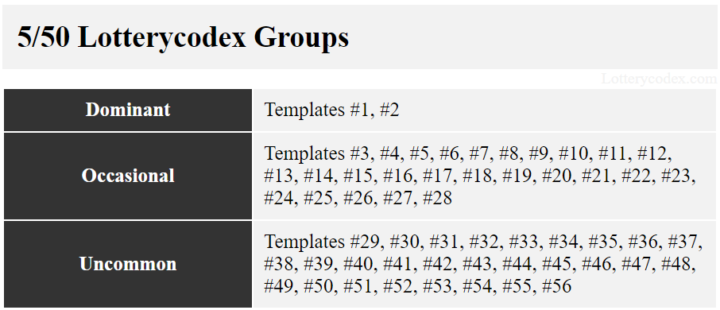
Generated by Lotterycodex calculator
As a Eurojackpot player, you should buy tickets with combinations that frequently occur in a lottery draw. These dominant templates have favorable success-to-failure ratios.
How to Win EuroJackpot Game
Remember that buying tickets is the only way to increase your odds of winning. However, buying tickets randomly is not an effective method. Mathematically speaking, a lottery wheel gives you the mathematical advantage of trapping the winning numbers. Read on: Lottery Wheel: A Clever Mathematical Strategy That Works
Using the Lotterycodex calculator as a lottery wheel, the program will help you make informed choices as it separates the dominant from the rare groups, making number selections easy. Read on: Lottery Calculator: A Mathematical Guide Beyond Number Selection
With Lotterycodex analysis, we can finally see what dominates a lottery game.
As a lottery player, you aim to know how to win the Eurojackpot. It would be best to use the templates that will lead your way in that direction.
Look at the following Lotterycodex prediction of how a Eurojackpot game will behave over time:

Generated by Lotterycodex calculator
Based on the above table, template #1 dominates the Eurojackpot game, and according to the law of large numbers, template #1 will continue to show dominance even after 5000 draws.
This probabilistic prediction is a mathematical certainty.
There are millions of combinations in EuroJackpot. How do you know you choose a combination with a favorable success-to-failure ratio?
These Lotterycodex templates will give you that simple access to the right information.
Join the Conversation
Do you know how to win Eurojackpot? I welcome your opinion. Please join and add value to the conversation. Share a specific strategy that works for you in the EuroJackpot game.
Here are some of the key takeaways that you might want to review:
To improve your chances of winning the Eurojackpot, you should use combinatorics and probability theory instead of statistics. Combinatorics involves understanding the combinations that can be formed from the lottery’s number set, assessing how many possible combinations exist, and identifying which are more prevalent. Probability theory, on the other hand, helps calculate the success-to-failure ratio for each combinatorial group, aiding you in making more informed decisions when selecting lottery numbers, thus potentially offering you more favorable shots.
I do not support common lottery myths and superstitions but emphasize a rational, mathematical approach to playing the lottery. In a random lottery game, superstitious beliefs or myths cannot influence the outcome. Your focus should be on using combinatorics and probability theory to understand the behavior of lottery balls in a random draw rather than relying on myths or superstitious strategies.
The success-to-failure ratio in choosing lottery numbers is important because it helps players make informed choices based on risk tolerance. This ratio describes the number of ways you can achieve favorable outcomes versus the number of ways you might not. This approach shifts the focus from random selection to a more strategic, mathematically-probability-based selection.
Nothing can guarantee a win in the Eurojackpot. A mathematical strategy is designed to help you make more informed choices. However, due to the inherent randomness and unpredictability of lottery draws, no strategy can assure a certain win. I advocate for a more analytical approach to playing the lottery instead of relying on luck or superstitions.
I do not recommend relying on lucky numbers or quick picks. Instead, I advocate for a mathematical approach to selecting lottery numbers. This method is based on understanding the probabilities and combinatorics of the game rather than choosing numbers based on personal superstitions or quick-pick options. The focus is on making informed choices using mathematical principles to improve your odds potentially.
Thank you for reading :)
Additional Resources
- 12 Prize Tiers in Eurojackpot [↩]
- Probability Theory [↩] [↩]
- The Truth About Winning Small Prizes in the Lottery [↩]
- Combinatorics [↩]
- The Lotto Secret: Three Math Strategies for Winning Revealed [↩]
- Odds and Probability Explained in the Context of a Lottery Game [↩]
- What is the difference between odds and probability? [↩]
- Law of Large Numbers [↩]
Isn’t depend on purely on luck. Otherwise there is so many mathematicians in Europe.
Most people call it purely luck, but mathematicians call it truly random.
Can there same repeated results drawn in euro jackpot? Twice same results in year
It’s not surprising. Here’s why: https://lotterycodex.com/unusual-combinations/
I would like to purchase the 5/50 euromillions codex generator, please advise me as to how I can make this purchase
For the Euromillions, you need the 5/50 calculator. Please go here: https://lotterycodex.com/lotterycodex-calculators/
Thank you for this nice article :)
I have a question. How can we assure that the drawing is really live? The drawing happening in a room where there is no one to see. They have a list of purchased numbers and they can keep repeating the drawing recording until they get a number that has less number of winners.
And in addition, if the recording is not live, they can buy the winning number before they broadcast the drawing result!
Best regards,
Diya
Hi,
Pretty good query, but there has never been any trust issues yet, draw happens in Helsinki, Finland, and the result is reviewed in Germany. After everything is ok, the result is published. Many have won 120 million Euros in the past, its a intercountry lottery. There is no issue with the trust.
Hi there :-)
In our eurojackpot we have to choose 5 main numbers from 1-50 and then additionally we have to choose two star numbers from 1-12
How would you solve this?
The low should be 1-6 and the high 6-12
The even 2,4,6,8,10,12
The odd 1,3,5,7,9,11
I’ve tried to analyse the previous numbers and you are totally right with the 2odd-3even, 3even-2odd, 2low-3high, 3high-2low
But the star numbers seem totally random although some were the winning numbers more often than others
Thank you in advance
Cheers
Hi, we don’t include the lucky stars in a probability study because it is not mathematically practical.
HI,
I’m following EuroJackpot,
Your theory seems reasonable, but what about the last two numbers? Are they not there.
Thanks
Khiansh
Hi Khiansh, we can do nothing about the extra two numbers. We can do the probability study, but it’s not mathematically practical at all.
Read here: https://lotterycodex.com/lottery-formula/
Hay algo que no he logrado entender, cómo sacas esos patrones #1, #2 etc?
Please read here: https://lotterycodex.com/lottery-formula/